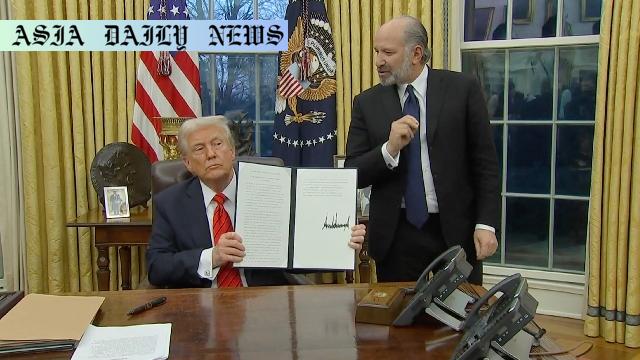Tariffs: US President Donald Trump has imposed a flat 25 percent tariff on foreign steel and aluminum, with new exceptions under review.
Trump imposes a 25% tariff on steel and aluminum imports.
Previous country exceptions under Biden’s administration revoked.
Possible consideration for new tariffs on auto, chip, and pharmaceutical sectors.
Australia may be granted an exception due to a trade surplus.

Introduction: The New Tariff Announcement
In a move that has reignited debates over international trade and economic policies, US President Donald Trump has imposed a 25 percent tariff on foreign steel and aluminum imports. This bold decision marks a significant increase from the previous 10 percent tariff on aluminum, signaling a renewed effort to prioritize domestic manufacturing and industry. The tariff announcement underscores Trump’s ongoing commitment to reviving American industries.
Policy Shift: A Focus on Domestic Production
Trump justified the imposition of higher tariffs by stating that steel and aluminum are integral to the nation’s infrastructure and future. He emphasized the need for these materials to be produced domestically rather than relying on international markets. “Our nation requires steel and aluminum to be made in America, not in foreign lands,” Trump declared, signaling his administration’s determination to bolster US manufacturing and protect local jobs.
Revocation of Exceptions and Special Cases
Under this policy, former exemptions introduced during Joe Biden’s administration have been revoked. Countries like Japan, which previously benefitted from duty-free quotas, will no longer enjoy special treatment. However, Trump noted a potential exception for Australia due to a trade surplus with the United States. Following a phone call with Australian Prime Minister Anthony Albanese, it was suggested that the administration may explore granting Australia a special exemption.
Potential Expansion: Tariffs Beyond Metals
The White House has hinted that the administration is considering expanding tariff impositions to other sectors such as automobiles, chips, and pharmaceuticals. This could mark a broader effort to strengthen key industries and reduce dependency on international supply chains, particularly in technology and healthcare. These considerations suggest that America’s trade policies could have wider implications for the global economy.
Mixed Reactions from Analysts and Nations
Economic policy experts have offered diverse reactions to Trump’s move. Supporters argue that high tariffs deter foreign competition, boosting domestic production and job creation. Critics, however, fear that these trade barriers could invite retaliatory tariffs from other countries and disrupt existing global supply chains. Furthermore, some experts caution the potential for inflationary effects if imported goods become more expensive for US consumers.
Historical Context: The Continuation of Trump’s Tariff Strategy
This announcement serves as a continuation of Trump’s previous strategies in his first term, during which he imposed tariffs on steel and aluminum while granting exceptions to Canada, Mexico, and Australia. He has frequently cited his earlier tariffs as instrumental in saving the American steel industry, framing this latest move as a further step toward achieving economic self-reliance and resilience.
Global Trade Implications
Trump’s tariff policies could have significant repercussions on multilateral trade relations. Countries impacted by the revised policy may seek alternative trade routes or retaliatory measures. The inclusion of potential tariffs on automobiles and advanced technologies like chips could disrupt industries heavily intertwined with the global supply chain. Experts have advised caution to ensure the policy does not inadvertently harm industries reliant on international collaboration.
Conclusion
As the new tariffs take effect on March 12, questions remain about their long-term economic impact. While supporters of the policy expect a resurgence of domestic industry, critics are wary of the global ramifications. This latest move reinforces the Trump administration’s commitment to putting “America First,” potentially reshaping both the domestic and international economic landscapes.
Commentary
Economic Protectionism: A Boon or a Risk?
Trump’s decision to impose higher tariffs on steel and aluminum reignites the long-standing debate between economic protectionism and free trade. On one hand, the move advocates for self-reliance and the protection of domestic jobs, which are critical to many working-class communities in the United States. However, it also raises concerns about potential disruptions to global trade partnerships and increased costs for American businesses dependent on imported materials.
Global Trade Dynamics in Focus
This announcement signals a clear shift back to policies that prioritize domestic industry under the “America First” banner. While this approach might drive a resurgence in US manufacturing, it risks alienating international allies and economic partners. The potential for retaliation or renegotiation of trade deals could unleash broader economic consequences, particularly if sectors like technology and healthcare are targeted in future tariffs.
Balancing Domestic Growth with International Relations
While ensuring the growth of America’s industrial base is a noble goal, the administration must strike a balance to avoid alienating key trade partners. Strategic collaboration could result in mutually beneficial policies, rather than a combative trade war. The potential exception for Australia demonstrates that nuanced diplomacy is possible, even within a protectionist framework.
Looking Ahead
As the full effects of these tariffs play out, it will be interesting to analyze their impact on domestic industries, consumer prices, and global relations. As an observer, I hope that the administration ensures the policy aligns with long-term economic goals without imposing unnecessary burdens on American citizens or jeopardizing critical partnerships.


